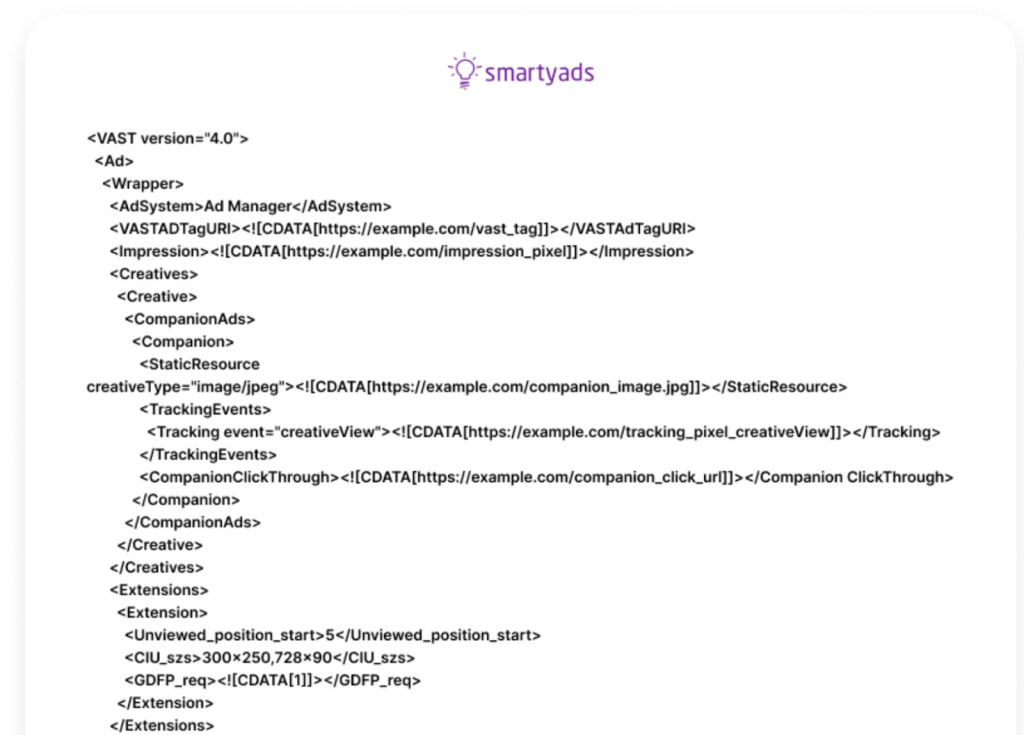In the bustling realm of digital advertising, where the competition is as fierce as ever, marketers and advertisers are seeking proven ways to grab the attention of their audiences and drive revenue. So today, we will talk about a video ad serving template (VAST), an unparalleled and fundamental tool that completely revolutionizes the landscape of digital advertising. Let’s explore it now! �
Table of Contents
Video Ad Serving Template: What It Is and Why It Is Important�
As video advertising keeps flourishing as the number of video traffic grows exponentially, digital experts embrace this potent content type with unprecedented ardor. The numbers speak for themselves. In 2023, digital video ad spending reached almost $177 billion; only the sky is the limit.
But what is video ad serving, and how can it be implemented in your video advertising strategy? As it all might seem a bit complicated at first glance, let’s dive into it step by step.
Simply put, video ad serving is the process that enables the showing of video ads on the publisher’s website and their delivery to the target audiences.
In its turn, a video ad serving template or VAST is a standardized video specification framework (script). It was released by the Interactive Advertising Bureau (IAB) with the goal of successfully delivering video ads from a video ad server to the publisher’s media player across multiple devices.
Why is VAST important for digital advertising? Well, it’s critical as it establishes a smooth connection between ad servers and video players and, as a result, a seamless ad delivery and playback experience.
For advertisers, it means being able to deliver their video ads through different devices and players. For publishers, it is beneficial as it guarantees a higher volume of inventory to sell and offers more ad impressions to advertisers. For both parties, it will surely simplify their efforts and drive revenue.
VAST Tag: Leveraging Advanced Feature�
Moving further, let’s dig even deeper and see what a VAST tag is. Basically, it’s an ad tag that can be created manually with Google Ad Server or any other third-party tool and then placed on a publisher’s website to display video ads. This piece of code written in XML schema ensures effective communication between an ad server and a video player.
It contains all the crucial information regarding the ad: the type of the ad, its dimensions and format, duration of the video, etc., to guarantee the ad is showcased as expected. The tag elements can be easily modified according to the publisher’s or advertiser’s requirements. However, usually, the VAST tag contains three core elements:
- media file
- video format
- tracking pixel
Take a look at the VAST tag example:�

VAST tag brings plenty of advantages to the video advertising process. Not only does it ensure smooth video delivery, but it also reduces playback errors, enabling better control over video distribution. Also, it can significantly reduce time and money spent as it’s a standardized practice that doesn’t require manual ad placement and minimizes all the challenges associated with video ad servings.
Maximizing Revenue Through VAST Monetization Best Practices
VAST is not just a technology tool. It can be a true cornerstone of your programmatic advertising strategy. To unlock its full potential, publishers and advertisers should stick to the best practices when leveraging video ad-serving templates.
If you are new to this technology, keep these important details in mind before generating your first VAST advertisement.
1. Adhere to VAST specifications
It is the foundation of the success of your future video ad campaigns. Make sure you follow all technical requirements to attain smooth performance, compatibility, and playback quality across any device. By strictly adhering to VAST specifications, you will minimize ad-serving errors, thus enhancing your monetization outcomes.
2. Double-check your code
Before launching your campaign, double-check your VAST tag for all the errors and possible typos, especially if you created it manually. It’s a simple yet effective strategy to mitigate potential technical issues that can be easily prevented.
3. Implement robust tracking�
As we’ve mentioned before, a tracking pixel is one of the integral parts of the VAST tag. Therefore, it’s crucial to introduce robust tracking mechanisms that will help you evaluate the performance of campaigns and boost their effectiveness while optimizing your monetization efforts.�
4. Leverage the power of A/B testing
A/B testing will enable advertisers to run different video ad formats and evaluate the performance and effectiveness of each one. By analyzing the performance, it will be possible to define what works better and how different video sizes and formats are displayed to modify and adjust for better results.
Future Trends in VAST: How It Will Shape the Digital Advertising Landscape
Looking into the future, it’s possible to certainly say that VAST will occupy a special place in the realm of digital advertising. As technologies keep advancing, VAST will also continue evolving and transforming the way we deliver video ads. Moreover, more and more targeting capabilities, analytics, and measurement tools will appear, thus enhancing VAST implementation and opening more broad opportunities for ROI growth for publishers and advertisers.
Summing It Up
As you can see, VAST is paramount for video advertising as it ensures seamless delivery of video ads to viewers across devices and platforms. We are witnessing a significant shift towards video advertisement, so understanding this technology and implementing the best practices will unlock endless opportunities for both publishers and advertisers to generate revenue, enhance monetization, and engage with audiences. It is already redefining the realm of digital advertising, so we should embrace this complex yet rewarding innovation.